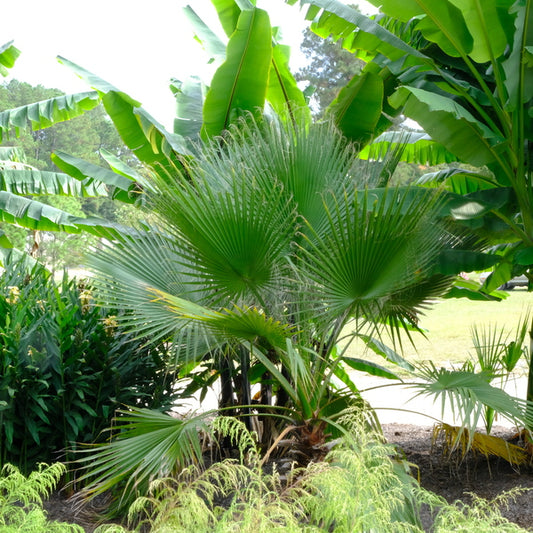-
 Sold out
Sold outWashingtonia filifera 'Denton'
Item #: 16923
Zones: 8a to 10b, guessing
Dormancy:
Height: 720" tall
Culture: Sun
Origin: United States
Pot Size: 3.5" pot (24 fl. oz/0.7 L)
Regular price $26.00Regular priceUnit price per
More Information About Washingtonia
The genus Washingtonia contains just 2 species of fan-leaved palm trees (Washingtonia filifera and Washingtonia robusta) native to the western US and western Mexico. The genus name Washingtonia commemorates our nation's first president, but they were not brought into cultivation until 80 years after his death. Like George Washington, Washingtonia is very tall. In fact, it is the tallest cold hardy palm tree in the world and old specimens can grow to over 100'. When you see the palm-lined streets of Los Angeles or Miami, they are usually Washingtonia palms.
In the wild, the old palm fronds do not fall off and are retained as a hula-skirt of thatch beneath the tree canopy. In cultivation, they are usually removed to present a cleaner appearance and to reduce the fire hazard and rodent populations (they like to build nests in the skirt). The toughness and beauty of Washingtonia means that it is used all over the world in places where the temperature never drops below 20 degrees F.
Luckily for us here in the frigid Southeast, there are a few cold hardy specimens of Washingtonia which we have been collecting to increase the number of hardy palms we offer. Cold hardy fan palms can be seen in places like Dallas, Oklahoma, Atlanta, Raleigh, and even coastal Virginia. The trees produce a cluster of small white flowers that are followed by small, brown, edible fruits.
Washingtonia prefers full sun and a moderately rich, well-drained soil. It can tolerate poor sandy soils with ease but may rot in heavy, continuously wet soils. Although drought-tolerant once established, Washingtonia looks best when given regular water. This is an easy palm to grow and looks good planted in a grove, as an allee, or in a container. It is also salt tolerant and is great for coastal gardens. The interspecific hybrid, Washingtonia x filibusta, is intermediate between the parents and is more tolerant of wet cold. With a name like that, we should plant it around the Capitol building in Washington, DC.

